Spaghetti
Big Screen Big Tune #2 - Django
Yeah, yeah, yeah, we all know that Ennio Morricone was the true king of the Spaghetti Western soundtrack but there were definitely some others out there too!
For the second Big Screen, Big Tune, we present Luis Bacalov’s theme song for Django.
Chorus: django!
Django, have you always been alone?
Chorus: django!
Django, have you never loved again?
Love will live on, oh oh oh…
Life must go on, oh oh oh…
For you cannot spend your life regreatting.
Chorus: django!
Django, you must face another day.
Chorus: django!
Django, now your love has gone away.
Once you loved her, whoa-oh…
Now you’ve lost her, whoa-oh-oh-oh…
But you’ve lost her for-ever, django.
When there are clouds in the skies, and they are grey.
You may be sad but remember that love will pass away.
Oh django!
After the showers is the sun.
Will be shining…
[instrumental solo]
Once you loved her, whoa-oh…
Now you’ve lost her, whoa-oh-oh-oh…
But you’ve lost her for-ever, django.
When there are clouds in the skies, and they are grey.
You may be sad but remember that love will pass away.
Oh django!
After the showers is the sun.
Will be shining…
Django!
Oh oh oh django!
You must go on,
Oh oh oh django…
The Nights of Terror (Le Notti del Terrore)
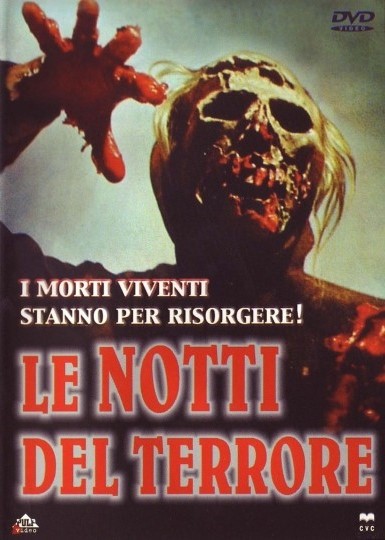
Another day, another Spaghetti Zombie flick. Fresh from the prime years of Italia’s Zombie cycle comes Andrea Bianchi’s Nights of Terror.
This film has been called a lot of things. Good isn’t usually one of them. IMDb reviews run from a verdict of “unintentionally hilarious” to “unbearably awful” and, whilst there’s definitely elements of the latter, I must side with the former.
Like so many of the others (and indeed, most of the films I cover here…) it gets off to a bad start on paper.
- Andrea Bianchi cut his teeth very much on the porn side of exploitation films: his previous titles to this included Confessions of a Frustrated Housewife, Strip Nude for Your Killer and The Erotic Dreams of a Lady.
- The film has almost no plot
- The scenes are pretty much split equally between the central characters fumbling with each other and the central characters being hunted by zombies.
Of course, you could very well argue that some of those may be positives….
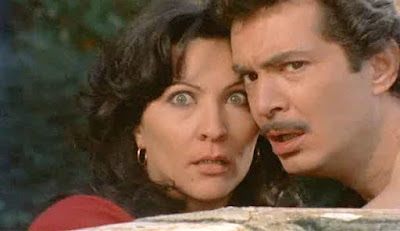
^^ There is literally nothing that gives away that this film was made in 1980.^^
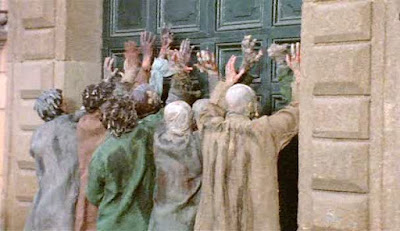
The ‘plot’ can be pretty easily dismissed as: luxury-loving loved-up couples spend some time at a castle/mansion house. Zombies rise from their graves. Zombies kill central characters. The end.
The characters are similarly bland; in the film’s defence, things to move at a good enough pace that we are hardly given time to consider how little depth Bianchi gives his protagonists but…. on the flipside: whenever any one of them dies, there’s a fairly large temptation to shrug your shoulders and mutter, “oh well”. It’s not as if we really ever care about any of them. The women especially (as might be expected from a 1980 Italian exploitation horror) are completely characterless. Of the prominent women, one is zombified fairly early, the other encounters her slaughtered son and hardly utters another word whilst the third…. She is so enormously irritating in the typical ‘all-a-woman-can-do-when-confronted-by-something-scary-is-scream’ manner that, when she stumbles into a (rather oddly placed) bear-trap, I was vaguely pleased. Sadly, all it means is that she screamed and squawked for the rest of the film, albeit now with added limping.
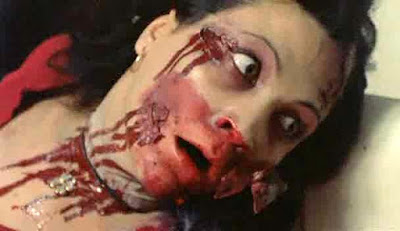
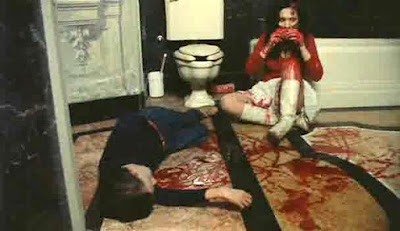
Frustratingly boring characters aside, the zombification is quite fun. The make-up is somewhat heavier than normal (in the vein of the Spanish conquistadores of Fulci’s Zombi 2) but they are pleasingly grotty with maggots and all. The gore is a little thin on the ground perhaps, but the bits we do get are fairly satisfying. And THAT breast-feeding moment needs no more elaboration…
Perhaps I’m being too harsh. After all, for all the lack of plot, the flat characters, the atrocious dubbing, the obviously budget-limited set, this film moves along at a keen pace and is a lot of fun. Maybe not one to treasure, watch again, or even remember but… if you’re after a fun film to watch, in which stupid people get killed by the undead, this might just fit your requirements.
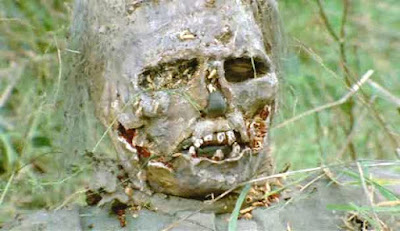
Cemetery Without Crosses (Une Corde, Un Colt)

Westerns are in an odd place these days. The culture of the Western is so deeply ingrained in our collective consciousness that everyone is familiar with some, if not all, of the classic clichés and norms of the Western film. Goodies wear white hats, baddies wear black. They smoke. They shoot. They drink whisky. They fight in bars. They barge through saloon doors, chase each other on horses across the desert, dash over the border to Mexico when the heat’s on, have quick-draw shoot-outs at high noon, etc, etc.
Part of the reason for this collective knowledge is that Western films were simply MASSIVE once upon a time. A well-established genre on both sides of the Atlantic, Western films were big business whilst (for the European Spaghetti Westerns at least) being dirt cheap to produce.
So why, years later do we remember the clichés but forget the films? Why do we remember only Clint Eastwood as THE Western star, Segio Leone as THE director and Ennio Morricone as THE composer?
THe simple, obvious and so most likely true (thanks Occam’s razor…) answer to these questions is that, despite the enormous number of Wesrern films they were mostly pretty damn similar, forcing us to rememember the key clichés but being otherwise mostly forgettable. Eastwood, Leone and Morricone just happened to be the best…
Of course, this doesn’t mean we should forget the rest. There are some excellent Westerns available and Cemetery Without Crosses is one of the best. And guess what? Neither Eastwood nor Morricone are anywhere to be seen!

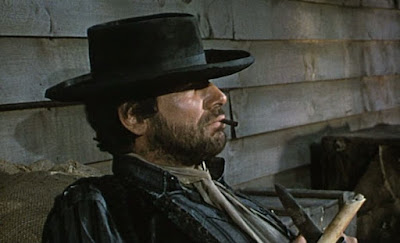
Leone however, does stamp his presence here; the film is very much a tribute to his style (which is no bad thing!) and he even guest directed what is possibly the best and most tense scene of the movie, the meal at the Rogers family ranch.
THe story, then, is interesting and tense, albeit very predictably Spaghetti-Western-y. Despite Manuel’s (Robert Hossein) rebuttal of “You believe in revenge. I don’t. It never ends”, this is a story of revenge and, equally predictably, it all ends in tears.
The Rogers have killed one of the Caines and, though the brother Caines are preparing to flee with their cash, the freshly-widowed Mrs.Caine is spitting blood and demmands revenge. Cue involvement of old flame Manuel and a whole lot of people getting shot.
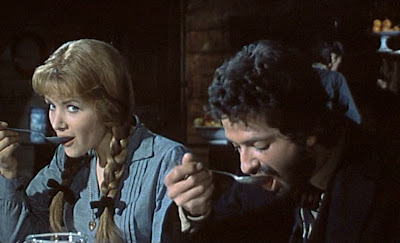
Sexual tension in the Leone-directed dining scene…
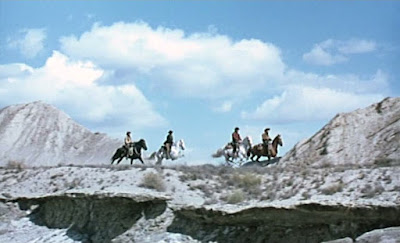
So no great innovation in terms of plot, but sometimes its executgion rather than originality that’s important. What is noticeable is an unusually positive role for women. Western’s female characters tended to be demure and pathetic or prostitutes; here we are thankfully given some strong women who manage to assert themselves. Even without taking off their clothes! Something of a rarity for cheap films of the era…
Cemetery Without Crosses is beautifully shot - full of lots of long static camera angles - and keeps tension high throughout, with sparse dialogue and long silences that threaten to bore at times but mostly thrill. The soundtrack doesn’t suffer either, director and star Rob Hossein’s father André providing some suitably stompy, whistle-y tunes that fit the picture perfectly.
In all, Cemetery Without Crosses is an exciting, well-written and well-directed Spaghetti Western that, although probably somewhat forgettable, is `definitely an entertaining watch.
As an extra aside, it is worth noting the writing credit given to a certain b-movie legend, Mr Dario Argento. Argento was fresh from a taste of success in writing for Sergio Leone’s (him again) Once Upon A Tine in the West and obviously saw another Western as a sensible move. Director Rob Hossein has since claimed however that Argento played no role in the cresation of the film, suggesting that his onvolvement might not have gone as smoothly as hoped…